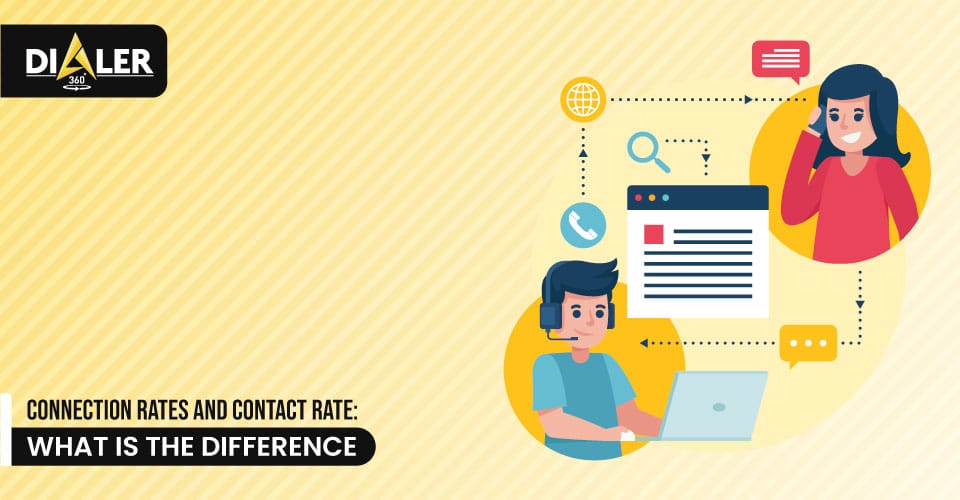
When it comes to measuring the success of a sales team, several metrics can be used. Two of the most important metrics are connection rates and contact rates. While they may seem similar, there are important differences between the two that sales managers and representatives need to understand.
Every business wants to attract leads and convert them but it has become difficult for agents to connect and hear from customers. All this due to the excessive practice of customer calling has stopped customers from answering most phone calls or making contact with a brand.
No matter what your contact center offers, you need to have high contact and connection rates. So, think of out-of-the-box calling solutions to boost contact and connection rates.
What is a Connection Rate?
A connection rate measures the percentage of attempted calls or outreach attempts that result in some form of connection with the intended prospect.
This could be an answered call, an email reply, or a message through a social media platform. Connection rates are a key performance indicator for sales representatives, as they measure the effectiveness of their outreach efforts.
How to calculate the connection rate:
(Number of successful connections/Number of attempted connections) x 100 = Connection rate
For example, if a sales representative makes 100 calls in a day and successfully connects with 20 prospects, the connection rate would be 20%.
What is a Contact Rate?
A contact rate measures the percentage of attempted calls or outreach attempts that result in a meaningful conversation with the intended prospect. This could be a phone call where the prospect shows interest in the product or service being offered or an email exchange that leads to a meeting.
Contact rates are a more important metric than connection rates, as they measure the effectiveness of the sales representative in converting connections into meaningful conversations.
How to calculate the contact rate:
(Number of live person contacts ÷ Total leads on the list) x 100 = Contact rate
For example, if a sales representative makes 100 calls in a day and successfully connects with 20 prospects, but only has meaningful conversations with 10 of them, the contact rate would be 10%.
Why Are Connection Rates Important?
Connection rates are important because they give sales managers and representatives a sense of how effective their outreach efforts are. If a sales representative is making 100 calls a day and only connecting with five prospects, it may be an indication that their approach needs to be adjusted.
Moreover, by tracking connection rates, sales teams can identify patterns and adjust their approach accordingly to improve their effectiveness.
Reasons to matter connection rates in a call center
1. Efficiency
Connection rates directly affect the number of successful contacts made by the call center. However, a high connection rate means that more calls are being answered by customers, which translates to more opportunities for call center agents to engage with customers and achieve their goals.
2. Productivity
Higher connection rates also mean that agents are spending less time waiting for calls to be answered, which can increase their productivity.
3. Cost savings
A high connection rate means that the call center is making the most out of its resources, which can result in cost savings.
4. Customer satisfaction
Customers are more likely to be satisfied with their experience if their calls are answered promptly.
A high connection rate means that customers are less likely to experience long wait times and are more likely to have their issues addressed promptly.
However, a high connection rate is a key performance metric for call centers, as it can have a significant impact on efficiency, productivity, cost savings, and customer satisfaction.

Why Are Contact Rates More Important?
While connection rates are important, contact rates are more important because they measure the ultimate goal of any sales outreach effort. converting prospects into customers. A sales representative may be able to connect with a large number of prospects, but if they are not having meaningful conversations, they are unlikely to close any deals.
By tracking contact rates, sales teams can identify which outreach efforts are most effective at converting prospects into customers. However, they can identify which prospects are most likely to convert and adjust their approach accordingly to increase their chances of success.
How do you Improve Contact Rates
Once you have tracking contact rates, the next step is to improve them. Here are a few steps that you take to improve contact rates:
Know your customers
Make a quality list of people before calling customers. An unreliable database is only time-consuming and lost money in your call center business.
Moreover, calling those people who are interested in your products or services to improve contact rates. Knowing basic demographic information will help them make their talking point more relevant to that customer.
Adjust Automatic Dialing
Utilize an automatic dialing system to make more calls and save time and money. Furthermore, agents have more time to resolve customer complex issues ultimately increasing customer satisfaction and business revenue.
Train Your Agents
Train your call center agents to handle objections, stay on script, and maintain a professional demeanor. This will increase their confidence and improve their chances of success.
Leave a Voicemail
When you are unable to connect with a live customer despite your best efforts, leaving a voicemail can be an effective alternative. The voicemail message should be concise and compelling, highlighting the unique value proposition of your product or service.
While the customer may not return your call based on your voicemail alone, it can help create a positive first impression and increase the chances of a future connection. Crafting an effective voicemail is an important step in establishing a relationship with potential customers, even when you cannot speak with them directly.
Conclusion
In conclusion, while connection rates and contact rates are related, they measure different aspects of the sales process. Connection rates measure the effectiveness of outreach efforts, while contact rates measure the ability of sales representatives to convert prospects into customers.
Both metrics are important, but contact rates should be the primary focus for any sales team looking to improve their effectiveness. By tracking these metrics, sales teams can identify patterns, adjust their approach, and ultimately improve their ability to close deals.
Dialer360 provides advanced call center software that meets your lead conversion goal by improving contact and connection rates.




